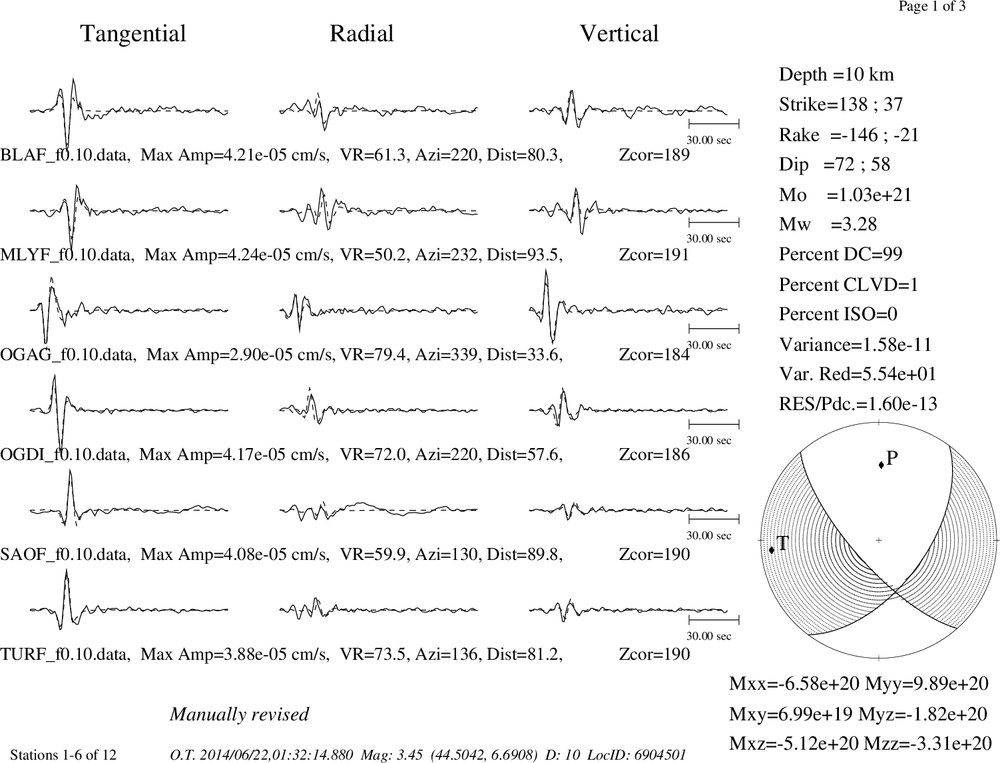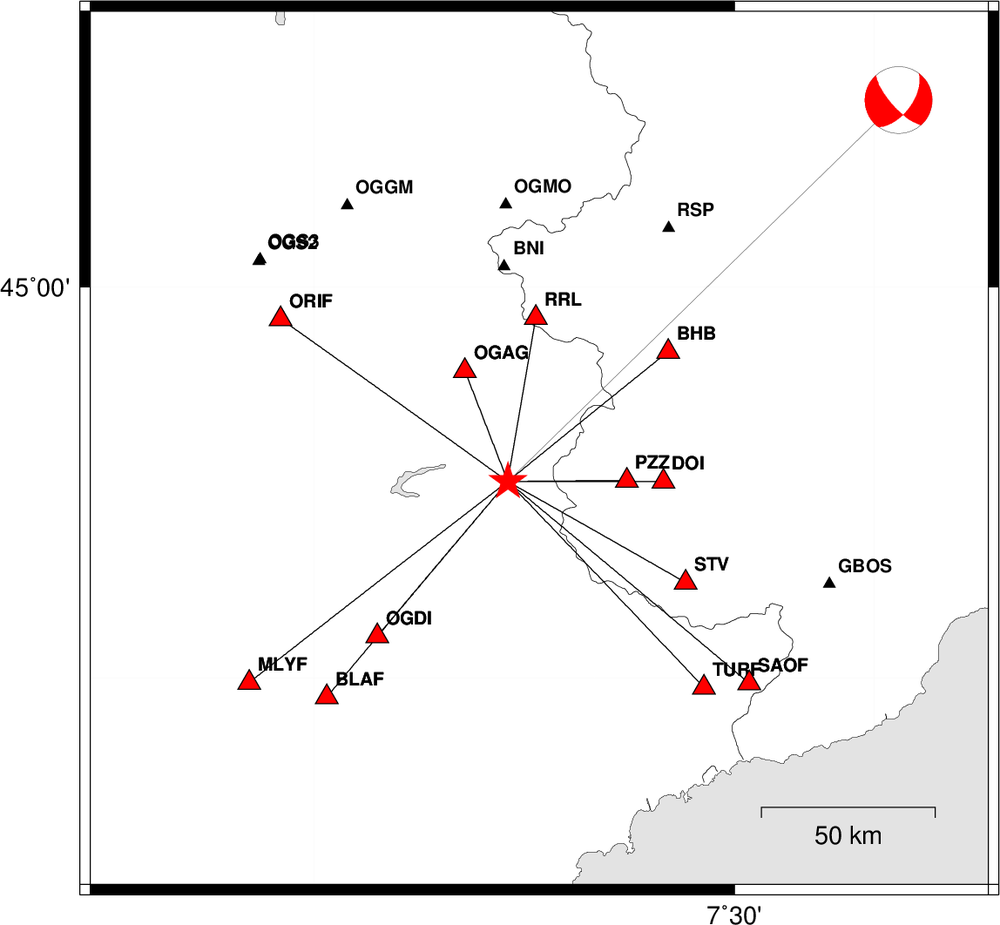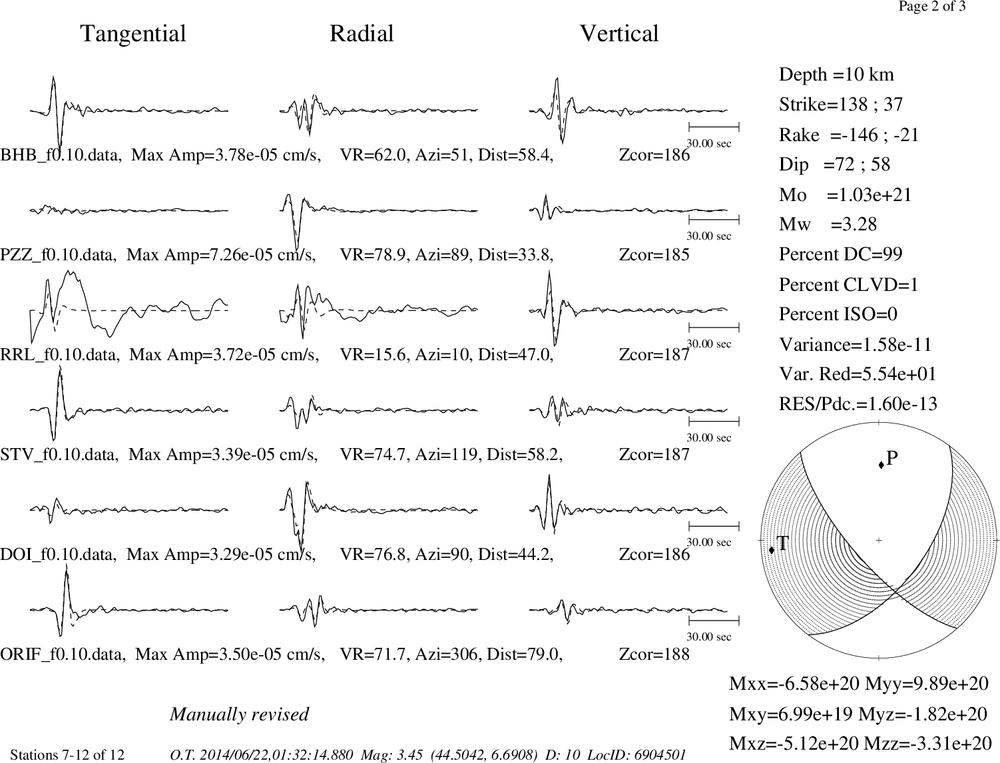Location
2014/06/22 01:32:14 44.50 6.69 12 4.1 France
Arrival Times (from USGS)
Arrival time list
Felt Map
USGS Felt map for this earthquake
USGS Felt reports archive
Focal Mechanism
USGS/SLU Moment Tensor Solution
ENS 2014/06/22 01:32:14:0 44.50 6.69 12.0 4.1 France
Stations used:
CH.BNALP CH.BRANT CH.DIX CH.FIESA CH.GIMEL CH.GRIMS
CH.HASLI CH.LAUCH CH.LLS CH.MMK CH.SENIN CH.TORNY CH.VANNI
CH.WIMIS FR.ARBF FR.ARTF FR.BLAF FR.BSTF FR.CALF FR.GRN
FR.ISO FR.MLYF FR.MON FR.OG02 FR.OG35 FR.OGAG FR.OGDI
FR.OGGM FR.OGMO FR.OGS1 FR.OGS2 FR.OGS3 FR.OGSM FR.RSL
FR.RUSF FR.SAOF FR.TRBF FR.TURF G.SSB GU.BHB GU.ENR GU.GBOS
GU.PZZ GU.RRL GU.RSP GU.STV GU.TRAV IV.DOI IV.MONC IV.MRGE
IV.QLNO MN.BNI RD.ORIF
Filtering commands used:
cut o DIST/3.3 -40 o DIST/3.3 +70
rtr
taper w 0.1
hp c 0.02 n 3
lp c 0.06 n 3
Best Fitting Double Couple
Mo = 1.48e+21 dyne-cm
Mw = 3.38
Z = 12 km
Plane Strike Dip Rake
NP1 143 75 -138
NP2 40 50 -20
Principal Axes:
Axis Value Plunge Azimuth
T 1.48e+21 16 266
N 0.00e+00 46 160
P -1.48e+21 40 10
Moment Tensor: (dyne-cm)
Component Value
Mxx -8.43e+20
Mxy -6.04e+19
Mxz -7.41e+20
Myy 1.34e+21
Myz -5.07e+20
Mzz -4.98e+20
--------------
----------------------
##-------------------------#
###------------- ----------#
######------------ P ----------###
#######------------ ----------####
#########------------------------#####
###########-----------------------######
############----------------------######
##############--------------------########
## ###########-----------------#########
## T ############---------------##########
## #############-------------###########
###################----------###########
####################--------############
#####################----#############
####################################
###################----###########
#############----------#######
#######------------------###
----------------------
--------------
Global CMT Convention Moment Tensor:
R T P
-4.98e+20 -7.41e+20 5.07e+20
-7.41e+20 -8.43e+20 6.04e+19
5.07e+20 6.04e+19 1.34e+21
Details of the solution is found at
http://www.eas.slu.edu/eqc/eqc_mt/MECH.EU/20140622013214/index.html
|
Preferred Solution
The preferred solution from an analysis of the surface-wave spectral amplitude radiation pattern, waveform inversion and first motion observations is
STK = 40
DIP = 50
RAKE = -20
MW = 3.38
HS = 12.0
The NDK file is 20140622013214.ndk
The waveform inversion is preferred.
Moment Tensor Comparison
The following compares this source inversion to others
| SLU |
INGVTDMT |
USGS/SLU Moment Tensor Solution
ENS 2014/06/22 01:32:14:0 44.50 6.69 12.0 4.1 France
Stations used:
CH.BNALP CH.BRANT CH.DIX CH.FIESA CH.GIMEL CH.GRIMS
CH.HASLI CH.LAUCH CH.LLS CH.MMK CH.SENIN CH.TORNY CH.VANNI
CH.WIMIS FR.ARBF FR.ARTF FR.BLAF FR.BSTF FR.CALF FR.GRN
FR.ISO FR.MLYF FR.MON FR.OG02 FR.OG35 FR.OGAG FR.OGDI
FR.OGGM FR.OGMO FR.OGS1 FR.OGS2 FR.OGS3 FR.OGSM FR.RSL
FR.RUSF FR.SAOF FR.TRBF FR.TURF G.SSB GU.BHB GU.ENR GU.GBOS
GU.PZZ GU.RRL GU.RSP GU.STV GU.TRAV IV.DOI IV.MONC IV.MRGE
IV.QLNO MN.BNI RD.ORIF
Filtering commands used:
cut o DIST/3.3 -40 o DIST/3.3 +70
rtr
taper w 0.1
hp c 0.02 n 3
lp c 0.06 n 3
Best Fitting Double Couple
Mo = 1.48e+21 dyne-cm
Mw = 3.38
Z = 12 km
Plane Strike Dip Rake
NP1 143 75 -138
NP2 40 50 -20
Principal Axes:
Axis Value Plunge Azimuth
T 1.48e+21 16 266
N 0.00e+00 46 160
P -1.48e+21 40 10
Moment Tensor: (dyne-cm)
Component Value
Mxx -8.43e+20
Mxy -6.04e+19
Mxz -7.41e+20
Myy 1.34e+21
Myz -5.07e+20
Mzz -4.98e+20
--------------
----------------------
##-------------------------#
###------------- ----------#
######------------ P ----------###
#######------------ ----------####
#########------------------------#####
###########-----------------------######
############----------------------######
##############--------------------########
## ###########-----------------#########
## T ############---------------##########
## #############-------------###########
###################----------###########
####################--------############
#####################----#############
####################################
###################----###########
#############----------#######
#######------------------###
----------------------
--------------
Global CMT Convention Moment Tensor:
R T P
-4.98e+20 -7.41e+20 5.07e+20
-7.41e+20 -8.43e+20 6.04e+19
5.07e+20 6.04e+19 1.34e+21
Details of the solution is found at
http://www.eas.slu.edu/eqc/eqc_mt/MECH.EU/20140622013214/index.html
|
|
Waveform Inversion
The focal mechanism was determined using broadband seismic waveforms. The location of the event and the
and stations used for the waveform inversion are shown in the next figure.

|
|
Location of broadband stations used for waveform inversion
|
The program wvfgrd96 was used with good traces observed at short distance to determine the focal mechanism, depth and seismic moment. This technique requires a high quality signal and well determined velocity model for the Green functions. To the extent that these are the quality data, this type of mechanism should be preferred over the radiation pattern technique which requires the separate step of defining the pressure and tension quadrants and the correct strike.
The observed and predicted traces are filtered using the following gsac commands:
cut o DIST/3.3 -40 o DIST/3.3 +70
rtr
taper w 0.1
hp c 0.02 n 3
lp c 0.06 n 3
The results of this grid search from 0.5 to 19 km depth are as follow:
DEPTH STK DIP RAKE MW FIT
WVFGRD96 1.0 40 85 5 2.96 0.2501
WVFGRD96 2.0 65 60 35 3.14 0.3344
WVFGRD96 3.0 55 65 25 3.16 0.3656
WVFGRD96 4.0 40 40 -20 3.25 0.4108
WVFGRD96 5.0 35 40 -25 3.28 0.4574
WVFGRD96 6.0 40 45 -25 3.29 0.4950
WVFGRD96 7.0 35 45 -30 3.31 0.5236
WVFGRD96 8.0 30 40 -35 3.37 0.5495
WVFGRD96 9.0 35 45 -30 3.37 0.5663
WVFGRD96 10.0 35 45 -30 3.38 0.5744
WVFGRD96 11.0 40 50 -25 3.38 0.5770
WVFGRD96 12.0 40 50 -20 3.38 0.5781
WVFGRD96 13.0 40 50 -20 3.39 0.5766
WVFGRD96 14.0 40 50 -15 3.39 0.5735
WVFGRD96 15.0 40 55 -15 3.39 0.5703
WVFGRD96 16.0 40 55 -15 3.40 0.5663
WVFGRD96 17.0 40 55 -15 3.41 0.5614
WVFGRD96 18.0 40 55 -10 3.41 0.5561
WVFGRD96 19.0 40 55 -10 3.42 0.5508
WVFGRD96 20.0 40 55 -10 3.42 0.5446
WVFGRD96 21.0 40 55 -10 3.43 0.5385
WVFGRD96 22.0 40 55 -10 3.44 0.5315
WVFGRD96 23.0 45 55 5 3.44 0.5252
WVFGRD96 24.0 45 55 5 3.44 0.5191
WVFGRD96 25.0 45 55 5 3.45 0.5126
WVFGRD96 26.0 45 55 10 3.45 0.5060
WVFGRD96 27.0 45 55 10 3.46 0.4995
WVFGRD96 28.0 45 55 10 3.46 0.4926
WVFGRD96 29.0 45 60 10 3.46 0.4858
The best solution is
WVFGRD96 12.0 40 50 -20 3.38 0.5781
The mechanism correspond to the best fit is

|
|
Figure 1. Waveform inversion focal mechanism
|
The best fit as a function of depth is given in the following figure:

|
|
Figure 2. Depth sensitivity for waveform mechanism
|
The comparison of the observed and predicted waveforms is given in the next figure. The red traces are the observed and the blue are the predicted.
Each observed-predicted component is plotted to the same scale and peak amplitudes are indicated by the numbers to the left of each trace. A pair of numbers is given in black at the right of each predicted traces. The upper number it the time shift required for maximum correlation between the observed and predicted traces. This time shift is required because the synthetics are not computed at exactly the same distance as the observed and because the velocity model used in the predictions may not be perfect.
A positive time shift indicates that the prediction is too fast and should be delayed to match the observed trace (shift to the right in this figure). A negative value indicates that the prediction is too slow. The lower number gives the percentage of variance reduction to characterize the individual goodness of fit (100% indicates a perfect fit).
The bandpass filter used in the processing and for the display was
cut o DIST/3.3 -40 o DIST/3.3 +70
rtr
taper w 0.1
hp c 0.02 n 3
lp c 0.06 n 3

|
|
Figure 3. Waveform comparison for selected depth
|

|
|
Focal mechanism sensitivity at the preferred depth. The red color indicates a very good fit to thewavefroms.
Each solution is plotted as a vector at a given value of strike and dip with the angle of the vector representing the rake angle, measured, with respect to the upward vertical (N) in the figure.
|
Discussion
The Future
Should the national backbone of the
USGS Advanced National Seismic System (ANSS)
be implemented with an interstation separation of 300 km, it is very likely that
an earthquake such as this would have been recorded at distances on the order of
100-200 km. This means that the closest station would have information on
source depth and mechanism that was lacking here.
Acknowledgements
Dr. Harley Benz, USGS, provided the USGS USNSN digital data.
The digital data used in this study were provided by Natural Resources Canada through their AUTODRM site http://www.seismo.nrcan.gc.ca/nwfa/autodrm/autodrm_req_e.php, and IRIS using their BUD interface.
Thanks also to the many seismic network operators whose dedication make this effort possible: University of Alaska, University of Washington, Oregon State University, University of Utah, Montana Bureas of Mines, UC Berkely, Caltech, UC San Diego, Saint L ouis University, Universityof Memphis, Lamont Doehrty Earth Observatory, Boston College, the Iris stations and the Transportable Array of EarthScope.
Velocity Model
The WUS used for the waveform synthetic seismograms and for the surface wave eigenfunctions and dispersion is as follows:
MODEL.01
Model after 8 iterations
ISOTROPIC
KGS
FLAT EARTH
1-D
CONSTANT VELOCITY
LINE08
LINE09
LINE10
LINE11
H(KM) VP(KM/S) VS(KM/S) RHO(GM/CC) QP QS ETAP ETAS FREFP FREFS
1.9000 3.4065 2.0089 2.2150 0.302E-02 0.679E-02 0.00 0.00 1.00 1.00
6.1000 5.5445 3.2953 2.6089 0.349E-02 0.784E-02 0.00 0.00 1.00 1.00
13.0000 6.2708 3.7396 2.7812 0.212E-02 0.476E-02 0.00 0.00 1.00 1.00
19.0000 6.4075 3.7680 2.8223 0.111E-02 0.249E-02 0.00 0.00 1.00 1.00
0.0000 7.9000 4.6200 3.2760 0.164E-10 0.370E-10 0.00 0.00 1.00 1.00
Quality Control
Here we tabulate the reasons for not using certain digital data sets
The following stations did not have a valid response files:
DATE=Wed Jun 25 05:21:13 CDT 2014
Last Changed 2014/06/22







